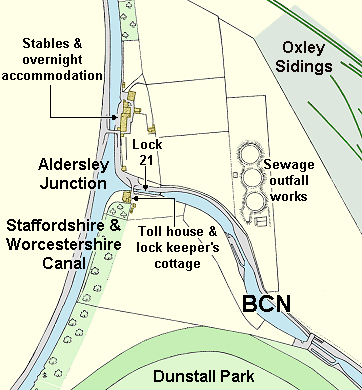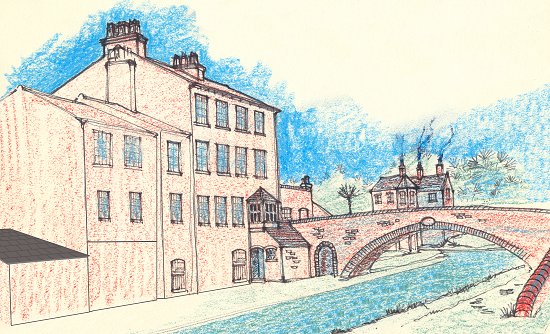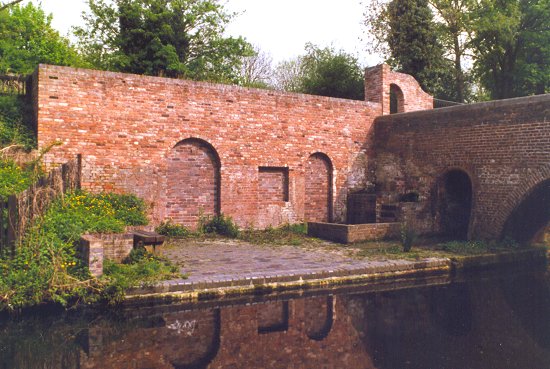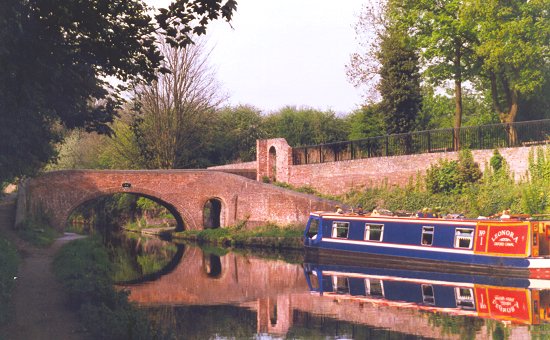 |
The racecourse extends to the end of the BCN at Aldersley
Junction, where it joins the Staffordshire and Worcestershire canal.
The BCN has fallen 133 feet in the last 1.8 miles from Broad Street
Basin, through a flight of 21 locks. There were originally 20 locks,
but the last lock at the junction was originally very deep and took
a long time to fill. The problem was overcome by the addition of
lock 20. At the end of lock 21, on the side of the racecourse, is the base
of the old toll office, and the lock keeper’s cottage, originally
occupied by John Brown, a carpenter who had previously worked on the
construction of the canal.
At the junction was a small isolated
settlement, consisting of several buildings, including stables, and a wharf. The
largest building, a 4 storey lodging house, had stables on the
ground floor, and offered overnight accommodation for canal boatmen
and their families.
|
| The four storey lodging house
by the roving bridge at Aldersley.
Horses entered the stables on the
ground floor via the small arch in the bridge.
In the background is the toll
house, and lock keeper's cottage. |

Based on a drawing by the late Ron
Eason. |
 |
What remains of the lodging
house. The lower part of the front wall now supports an
area of parkland above.
In the corner, by the bridge, is what appears to be the
remains of several small coal-fired ovens. |
| The roving bridge from the
other side. |
 |
|
Summary
It is now hard to imagine the busy canal in its heyday,
when large numbers of working boats travelled along its
length, carrying everything from coal, limestone, or
clay, to domestic items, furniture, and food. Today’s
tranquil scene couldn’t be more different. |
 |
When walking along the canal in the mid 1970s I met an ex-canal
boatman near Aldersley Junction. He began to reminisce about the old
days, and remembered what it was like in the 1930s and 1940s when a
large number of boats would join the queue to go up the 21 locks
from Aldersley. The boats often filled the canal from one side to
the other, during an overnight stay, making it possible to walk
across the canal, stepping from one boat to another. He remembered
occasionally having to wait two or three days to go up the locks,
because of the vast amount of traffic, travelling in both
directions. In its heyday the canal was the equivalent of our motorways, and
much of the area’s industry relied on it. The Black Country
grew, and developed, as the world's largest, successful,
and prosperous, industrial area thanks to the
canals. Similarly towns rapidly grew because all kinds of essential
goods could easily be transported for the first time. The canal was
an essential part of the commercial life of local towns, and many
wharves were built to allow the loading and unloading of almost
every kind of product.
|
| Things did change with the coming of the railways, but not to the
extent that is sometimes imagined. The BCN became an ally of the
London and North Western Railway, and from 1846 the canal was leased
to the railway, but remained under the control of its own
management. The greatest initial impact was the loss of passenger
traffic to the railways, it took some time for goods
traffic to be greatly affected.
Things changed quickly with the development of modern roads, and road
transport. From the mid 1930s increasingly large numbers of goods
were transported by road, and many of the canal haulage companies
either converted to road transport, or went out of business.
Similarly the old boating families had to find other work because of
the dominance of road haulage.
After a brief renaissance during the Second World War, the canals rapidly
declined, until the beginning of today’s leisure industry, when
they became a very different, and useful amenity. In the
intervening years many canals closed and have since disappeared, and
many have been re-opened and made navigable thanks to groups of
enthusiasts.
I hope this journey along the BCN has recaptured a little of the
atmosphere of the old canal. It was a vast service industry that greatly
benefited the local area, and much of the country, helping to make
it the prosperous place that it became. It is now referred to as
'the workshop of the world', and it all began thanks to the canals.
|
 |
Return to the Canals
and Industry Menu |
|